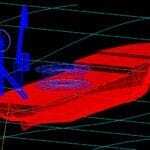[Posted on December 11th, 2013 by Bill Stewart]
Hydrodynamic analysis, the branch of fluid dynamics that deals with liquids in motion, is an important part of technology anything oceangoing or aquatic. Everything from ships to off-shore structures undergoes some form of this analysis. As the world increases its demand for energy, off shore structures are getting built in more extreme conditions, from deep water to arctic platforms, which require rigorous analysis before being built. Looking toward the future, hydrodynamics is helping solve the uncertainties around tidal generators, possibly turning it into a key energy resource.
Uses in the Energy Sector
The emergence of very large crude carriers has lead to an increase in single point moorings to allow the carriers to load and unload their cargo without the need for a large facility to house them. Given the cost of upwards up $387 million for a single terminal for even one of these moorings, performing solid hydrodynamic analysis is important, as any disruption can have major effects. Iraq is using the moorings to potentially double its output, and is planning to achieve this with only 4 facilities.
For offshore platforms that support drilling, operators need reliable and predictable performance, as well as prediction of wave loads that comes with accurate analysis. The analysis will also determine the safe operation conditions for offshore platforms.
Future Uses
With alternative energy becoming a larger part of the total energy market, tidal generators are being looked at as a way to harness tidal energy to cleanly generate electricity. It is not yet known how much energy can be extracted from the tides, and research is ongoing. This uncertain extends to all scales, from a single device to entire tidal basins.
What to look for
When looking for a company to perform such an analysis, you’ll want to look for a few things to make sure the company doing your analysis will do a good job. There are a variety of software tools used for this analysis, and you’ll want to make sure that the company you’re vetting uses at least some of the following software:
AutoHydro
Comflow
DeepC
Flow-3D
HydroD
Mimosa
OrcaFlex
Simo
Wadam
You’ll also want to make sure that the technology company you’re looking for has experience with many projects. While a theoretic background is also useful, teams with experience with real world projects in a variety of different environments will have the background to deal with any problems that come up.
Hydrodynamic analysis is an important part of any technology effort for aquatic structures, and making sure you have a reliable company that uses the latest techniques and software will ensure you get solutions to the challenges you face.



